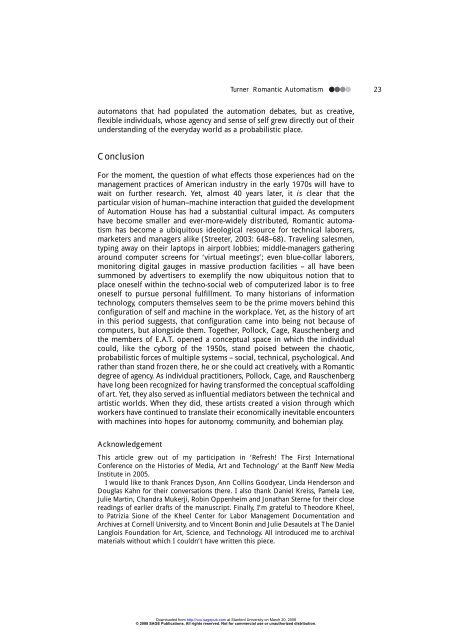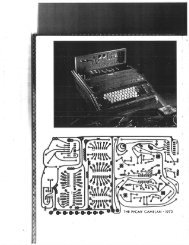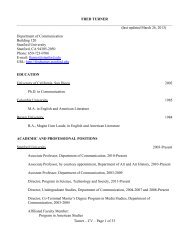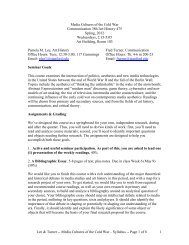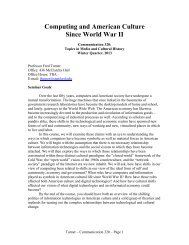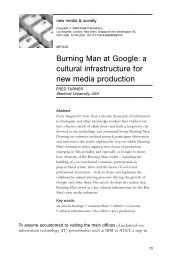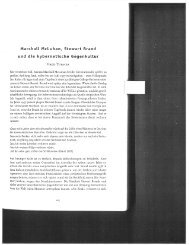Journal of Visual Culture - Fred Turner - Stanford University
Journal of Visual Culture - Fred Turner - Stanford University
Journal of Visual Culture - Fred Turner - Stanford University
You also want an ePaper? Increase the reach of your titles
YUMPU automatically turns print PDFs into web optimized ePapers that Google loves.
automatons that had populated the automation debates, but as creative,<br />
flexible individuals, whose agency and sense <strong>of</strong> self grew directly out <strong>of</strong> their<br />
understanding <strong>of</strong> the everyday world as a probabilistic place.<br />
Conclusion<br />
<strong>Turner</strong> Romantic Automatism 23<br />
For the moment, the question <strong>of</strong> what effects those experiences had on the<br />
management practices <strong>of</strong> American industry in the early 1970s will have to<br />
wait on further research. Yet, almost 40 years later, it is clear that the<br />
particular vision <strong>of</strong> human–machine interaction that guided the development<br />
<strong>of</strong> Automation House has had a substantial cultural impact. As computers<br />
have become smaller and ever-more-widely distributed, Romantic automatism<br />
has become a ubiquitous ideological resource for technical laborers,<br />
marketers and managers alike (Streeter, 2003: 648–68). Traveling salesmen,<br />
typing away on their laptops in airport lobbies; middle-managers gathering<br />
around computer screens for ‘virtual meetings’; even blue-collar laborers,<br />
monitoring digital gauges in massive production facilities – all have been<br />
summoned by advertisers to exemplify the now ubiquitous notion that to<br />
place oneself within the techno-social web <strong>of</strong> computerized labor is to free<br />
oneself to pursue personal fulfillment. To many historians <strong>of</strong> information<br />
technology, computers themselves seem to be the prime movers behind this<br />
configuration <strong>of</strong> self and machine in the workplace. Yet, as the history <strong>of</strong> art<br />
in this period suggests, that configuration came into being not because <strong>of</strong><br />
computers, but alongside them. Together, Pollock, Cage, Rauschenberg and<br />
the members <strong>of</strong> E.A.T. opened a conceptual space in which the individual<br />
could, like the cyborg <strong>of</strong> the 1950s, stand poised between the chaotic,<br />
probabilistic forces <strong>of</strong> multiple systems – social, technical, psychological. And<br />
rather than stand frozen there, he or she could act creatively, with a Romantic<br />
degree <strong>of</strong> agency. As individual practitioners, Pollock, Cage, and Rauschenberg<br />
have long been recognized for having transformed the conceptual scaffolding<br />
<strong>of</strong> art. Yet, they also served as influential mediators between the technical and<br />
artistic worlds. When they did, these artists created a vision through which<br />
workers have continued to translate their economically inevitable encounters<br />
with machines into hopes for autonomy, community, and bohemian play.<br />
Acknowledgement<br />
This article grew out <strong>of</strong> my participation in ‘Refresh! The First International<br />
Conference on the Histories <strong>of</strong> Media, Art and Technology’ at the Banff New Media<br />
Institute in 2005.<br />
I would like to thank Frances Dyson, Ann Collins Goodyear, Linda Henderson and<br />
Douglas Kahn for their conversations there. I also thank Daniel Kreiss, Pamela Lee,<br />
Julie Martin, Chandra Mukerji, Robin Oppenheim and Jonathan Sterne for their close<br />
readings <strong>of</strong> earlier drafts <strong>of</strong> the manuscript. Finally, I’m grateful to Theodore Kheel,<br />
to Patrizia Sione <strong>of</strong> the Kheel Center for Labor Management Documentation and<br />
Archives at Cornell <strong>University</strong>, and to Vincent Bonin and Julie Desautels at The Daniel<br />
Langlois Foundation for Art, Science, and Technology. All introduced me to archival<br />
materials without which I couldn’t have written this piece.<br />
Downloaded from<br />
http://vcu.sagepub.com at <strong>Stanford</strong> <strong>University</strong> on March 20, 2008<br />
© 2008 SAGE Publications. All rights reserved. Not for commercial use or unauthorized distribution.


